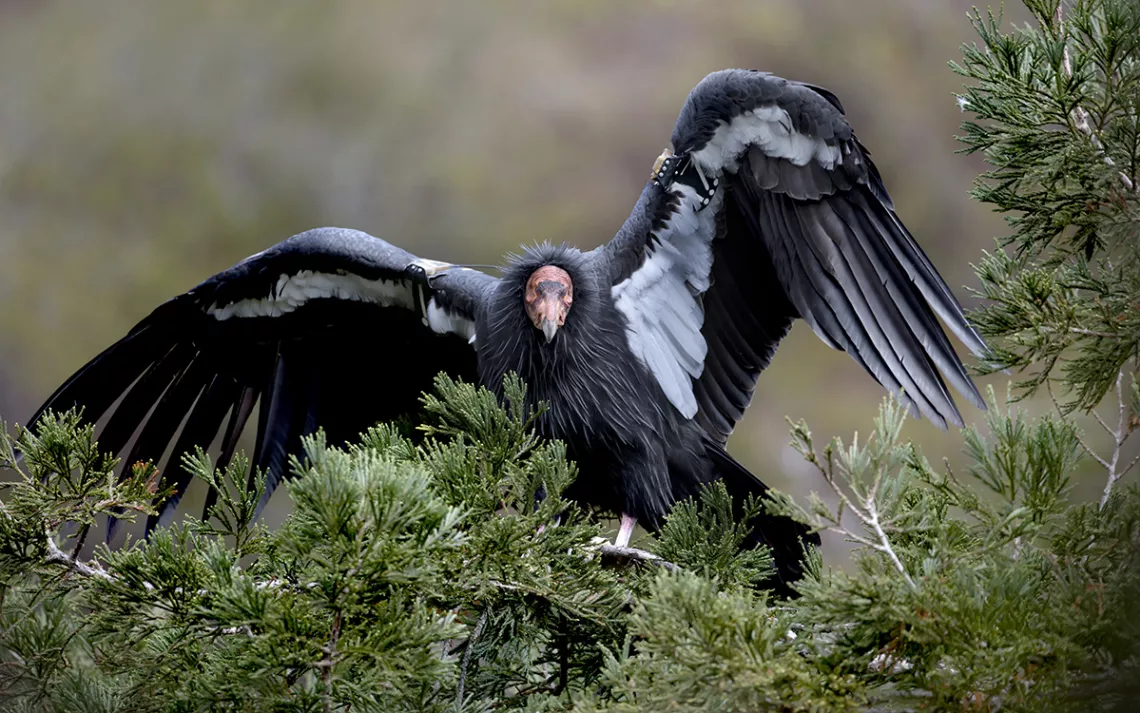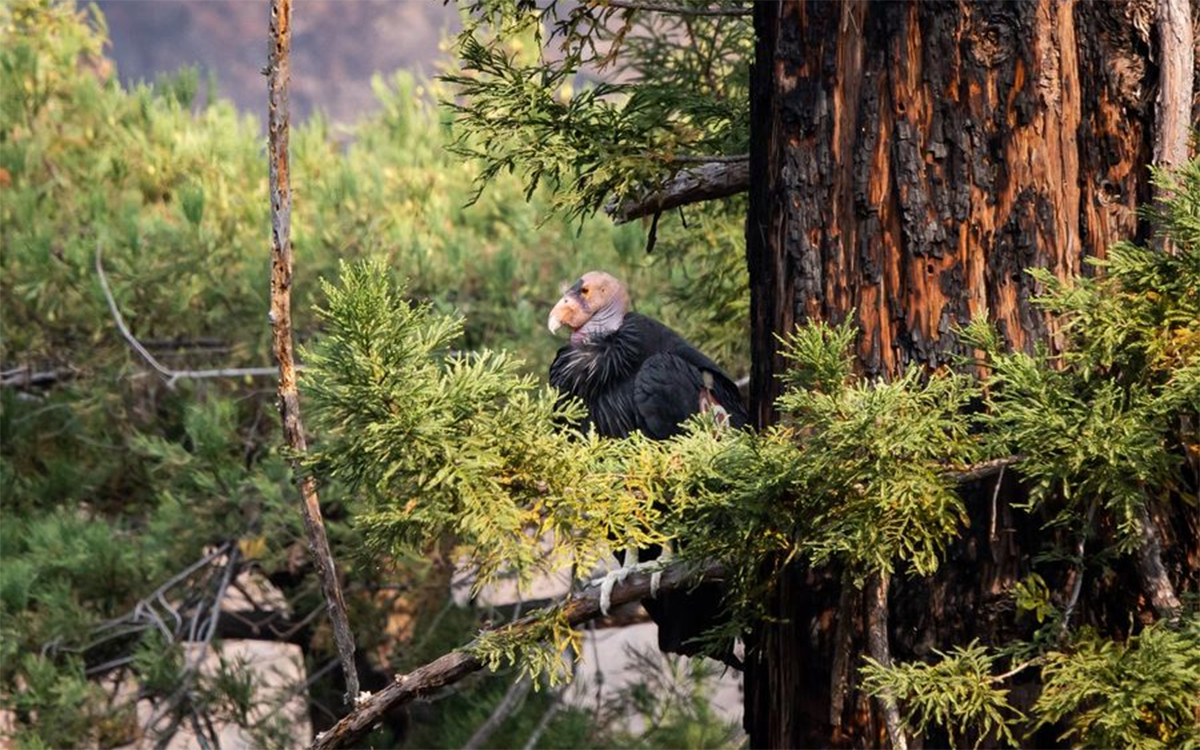Endangered Condors Become Casualties of the California Wildfires
One condor chick has proved to be a survivor

Photo by pjsells/iStock
Throughout this past spring and summer, as the COVID-19 pandemic raged, bird lovers and fans of the endangered California condor got the chance to spy on a condor chick being raised in a fire-charred redwood snag located in the Big Sur Condor Sanctuary. Staff with the Ventana Wildlife Society, which manages the sanctuary, named the chick Iniko, which means “born during troubled times” in Nigerian. Thanks to cameras provided by Explore.org, viewers were able to watch Iniko progress from a puff of down to gawky juvenile under the care of its parents, Kingpin and Redwood Queen. For many people, tracking Iniko became a much-needed antidote to the stresses of the pandemic.
On August 18, a fire touched off a mile south of the sanctuary. On the night of August 20, the Dolan Fire roared through the canyon where several condors were roosting and, along the way, destroyed the condor research facility. The webcam at Iniko’s nest captured the sound of crackling and gusting winds before flicking off. A second webcam, installed near the pens where juvenile condors are kept before being released into the wild, captured the approaching flames before it, too, went dark.
The Dolan Fire burned through five known condor nest sites. For days afterward, the fate of Iniko and the four other chicks at the site remained unknown. Nine free-flying adult and sub-adult condors had also gone missing.
“All condors missing were carrying radio transmitters, so the fact that no signals were found during the survey is very disappointing,” wrote Kelly Sorenson, executive director of the Ventana Wildlife Society, in an email update sent on September 1. “We are very worried because we know the fire burned through the sanctuary in the dark of night, when they would not have been able to evade the fire.”
Biologists and bird lovers were so concerned about Iniko and the other chicks because California condors are notoriously slow breeders, and because the species is still in jeopardy.
California condors are giant vultures with bald heads, curious natures, and wings that span over nine feet, making them the largest flying bird in North America. A bonded pair raises just one chick at a time; unless the nest fails, they only breed every other year. The condor’s slow reproduction rate is just one of the factors that led to their precipitous decline in the 20th century.
By the mid-1980s, the California condor faced almost certain extinction. At one point, there were as few as 22 members of the species left on the planet. Biologists pulled the last birds from the wild in 1987, a controversial move that only time would justify.
In the decades since, recovery of the critically endangered condor has been an all-hands-on-deck effort, led by the US Fish and Wildlife Service in partnership with the Oregon Zoo, Los Angeles Zoo, San Diego Wild Animal Park, Peregrine Fund, National Park Service, and wildlife agencies in several states. After a successful captive-breeding program began to increase condor numbers, biologists started releasing the birds back into the wild in 1992.
Today, there at least 410 California condors on Earth. Birds in the wild have established themselves in four distinct subpopulations: in Southern California, central California, northern Mexico, and northern Arizona/southern Utah. Although there are now more birds in the wild than in captivity, the population overall is still “dangerously small,” says Steve Kirkland, California Condor Field Coordinator for the US Fish and Wildlife Service.
Until the fire in Big Sur, 2020 had been a good year for the central California flock, which numbered around 100 birds in January. Last spring, biologists confirmed eight active nests within the Big Sur Sanctuary and nearby Pinnacles National Park.
After the fire, comments poured in through social media expressing concern for the missing birds, especially Iniko. But the fire still smoldered, and trees blocked the main road into the sanctuary, making it impossible for biologists to access the condor-rearing site.
Finally, on September 2, a field crew was able to venture into the charred area and check the nests. Two of the chicks had perished, but two, including Iniko, had survived. Staff had rescued a fifth chick before the fire reached its cliff-side nest. (That chick was transported to the Los Angeles Zoo, where it will likely remain for about a year before being released back into the wild.)
Iniko was alive, but for a few tense days, biologists weren’t sure if the chick was well. Kingpin was still missing, and Redwood Queen was not returning to the nest regularly. Iniko seemed lethargic and wasn’t fluttering its wings—an action that stimulates a condor parent to feed a chick. A few days later, VWS biologist Evan McWreath hiked to the redwood tree and reported that Iniko had rallied and was sporting a bulging crop—a sure sign he was being fed.
As of mid-October, nine free-flying birds are still missing, including the 24-year-old Kingpin, thought to be the dominant bird in the flock. Sorenson fears those adults and sub-adults didn’t survive.
“It’s a tough blow,” Sorenson says. “Of these nine missing birds, we had two or three breeding-age females. From a population standpoint, they are really critical.”

Photo courtesy Ventana Wildlife Society
Despite this dramatic and sudden loss of life, wildfires are not the condor’s greatest threat. Between 1992 and 2020, only seven free-flying birds and one nest had been lost to fire, Kirkland says. In 2008, a fire burned through an area of Big Sur that contained three nests, but no birds were lost.
In contrast, 92 birds have died from lead poisoning during that same period.
Condors are “obligate scavengers,” which means they feed exclusively on dead animals. When condors come across animals that have been shot and killed by humans, they often ingest tiny pieces of lead that have been left behind in the tissue. Since condors feed together, a single contaminated carcass can sicken many birds at once.
To help keep the wild condor population healthy, biologists supplement the flocks’ diets with lead-free carcasses. They also try to give the birds regular health checks to monitor their lead levels.
In July 2019, a California law went into effect that prohibits the use of lead ammunition for hunting (though lead ammo can still be used for target shooting). But, according to Sorenson, it can be hard to find non-lead ammunition in certain calibers, and it’s even harder to enforce the prohibition on its use. In 2012, Ventana Wildlife Society launched a program offering free copper ammunition to hunters and ranchers within the condor’s current range in California. Since then, VWS has provided over $250,000 worth of copper ammunition through its program, which is funded with federal and private dollars. The program focuses on educating gun owners about how lead impacts scavengers and demonstrating that copper ammunition is just as good as lead. (An older program in the Southwest, led by the Peregrine Fund and Arizona Game and Fish Department, has proved successful.)
In a morbid irony, biologists’ efforts to protect the condors from lead poisoning may have contributed to the high fire-related mortality from the Dolan Fire. Providing the birds with uncontaminated carcasses has created an artificially high concentration of condors at the Big Sur Condor Sanctuary.
As destructive as they are, wildfires also benefit condors by creating habitat. The redwood snag where Iniko was born was hollowed out by fire; fires also create openings that attract large animals, whether native deer or domestic livestock. “Succession after a fire creates a lot of forage,” says Chris Parish, director of global conservation for the Peregrine Fund. “A local population of deer might benefit, which leads to more natural mortality, which leads to more food.”
But when the Dolan Fire swept through Big Sur, the concentration of birds and nests in the sanctuary meant that a single fire event jeopardized a significant fraction of the total wild condor population. This is one reason why the 1996 California Condor Recovery Plan set a goal of three distinct populations with at least 150 individuals and 10 to 15 breeding pairs.
“Having several sub-populations and locations is an important tool in protecting very small or condensed populations from catastrophic loss,” Kirkland says. He hopes that eventually condors will be spread across the landscape, where they won’t be so vulnerable to a single catastrophic fire.
“That’s my vision,” Sorenson says, “to have multiple populations and release sites scattered all throughout their former habitat.”
Despite the recent fire-related losses, there are reasons to feel hopeful. Four condors were spotted roosting in Sequoia National Park in July, and later this year, biologists from the Yurok Tribe will release the first juveniles in Redwood National and State Park on California’s northern coast. VWS is raising funds to rebuild its facilities at the Big Sur sanctuary, and the organization plans to release seven birds at San Simeon, a site farther south on the coast, later this year.
In the meantime, Explore.org has restored two live-streaming cameras, so people can monitor the flock and watch as Iniko, who has surely earned its name, tests out its wings for the first time.
 The Magazine of The Sierra Club
The Magazine of The Sierra Club



